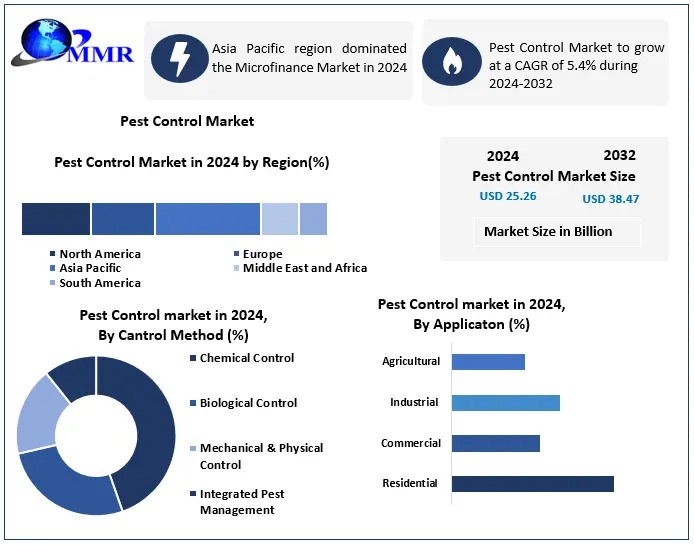Pest Control Market Size, Regional Analysis, and Forecast 2024–2032 (Business Opportunities - Other Business Ads)

USAOnlineClassifieds > Business Opportunities > Other Business Ads
Item ID 2937744 in Category: Business Opportunities - Other Business Ads
Pest Control Market Size, Regional Analysis, and Forecast 2024–2032 | |
Pest Control Market: Navigating Growth Amidst Rising Health Concerns and Technological Advancements The Pest Control Market is experiencing significant growth, driven by increasing health concerns, urbanization, and advancements in pest management technologies. According to Maximize Market Research, the market was valued at USD 25.26 billion in 2024 and is projected to reach USD 38.47 billion by 2032, expanding at a CAGR of 5.4% during the forecast period. Market Estimation & Definition Pest control encompasses the management and regulation of species classified as pests, which adversely affect human activities. This includes a variety of methods such as chemical, biological, mechanical, and physical techniques to prevent and eradicate pests like insects, rodents, and other unwanted organisms. The primary goal is to minimize the impact of pests on health, property, and the environment. Ask for Sample to Know US Tariff Impacts on Market @ Sample Link :https://www.maximizemarketresearch.com/request-sample/16704/ Market Growth Drivers & Opportunities 1. Rising Health Concerns: The increasing prevalence of vector-borne diseases, such as dengue, malaria, and Lyme disease, has heightened the demand for effective pest control solutions. Public health initiatives and awareness campaigns are further propelling market growth. 2. Urbanization and Infrastructure Development: Rapid urbanization, especially in developing countries, has led to increased construction activities, creating conducive environments for pests. The need to maintain hygiene and prevent infestations in urban settings is driving the demand for pest control services. 3. Technological Advancements: Innovations in pest control methods, including the use of IoT-enabled devices, drones, and eco-friendly pesticides, are enhancing the efficiency and effectiveness of pest management strategies. 4. Regulatory Support: Governments worldwide are implementing stringent regulations to control pest populations, especially in agriculture and food processing industries, ensuring food safety and public health. Emerging Trends Shaping the Future 1. Integrated Pest Management (IPM): There is a growing shift towards IPM practices that combine biological, cultural, physical, and chemical tools to minimize economic, health, and environmental risks. 2. Biological Control Agents: The use of natural predators and pathogens to control pest populations is gaining traction, offering sustainable and environmentally friendly alternatives to chemical pesticides. 3. Digital Pest Control Solutions: The adoption of digital technologies, such as remote monitoring and data analytics, is enabling real-time tracking and more precise pest control interventions. Segmentation Analysis By Type: Chemical Control: Utilization of pesticides and insecticides to eliminate pests. Mechanical Control: Physical methods like traps and barriers to prevent pest entry. Biological Control: Employing natural predators or pathogens to control pest populations. Others: Includes cultural and physical control methods. By Pest Type: Insects: Such as mosquitoes, termites, and bedbugs. Rodents: Including rats and mice. Others: Birds, reptiles, and other pests. By Application: Residential: Homes and apartments. Commercial: Offices, hotels, and restaurants. Industrial: Manufacturing units and warehouses. Agricultural: Farms and greenhouses. Country-Level Analysis United States: The U.S. holds a significant share of the global pest control market, driven by stringent regulations, high awareness levels, and the presence of major industry players. The demand is particularly strong in residential and commercial sectors, with a growing emphasis on eco-friendly solutions. Germany: Germany's pest control market is characterized by advanced technologies and a strong focus on sustainability. The country's strict regulatory framework and high standards for hygiene in food processing and healthcare sectors are key drivers of market growth. Ask for Sample to Know US Tariff Impacts on Market @ Sample Link :https://www.maximizemarketresearch.com/request-sample/16704/ Competitive Landscape The global pest control market is highly competitive, with several key players focusing on strategic initiatives such as mergers, acquisitions, and partnerships to strengthen their market positions. Major companies include: Terminix Global Holdings, Inc. Rollins, Inc. Rentokil Initial plc Ecolab Inc. Anticimex Group These companies are investing in research and development to introduce innovative and sustainable pest control solutions, catering to the evolving needs of consumers and regulatory requirements.  | |
| Related Link: Click here to visit item owner's website (0 hit) | |
| Target State: All States Target City : All Cities Last Update : Apr 25, 2025 5:51 AM Number of Views: 47 | Item Owner : Nilam Contact Email: (None) Contact Phone: (None) |
| Friendly reminder: Click here to read some tips. | |
USAOnlineClassifieds > Business Opportunities > Other Business Ads
© 2025 USAOnlineClassifieds.com
USNetAds.com | GetJob.us | CANetAds.com | UKAdsList.com | AUNetAds.com | INNetAds.com | CNNetAds.com | Hot-Web-Ads.com
2025-09-15 (0.400 sec)